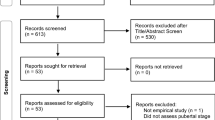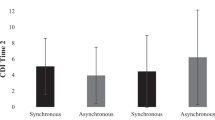Abstract
This study explored how pubertal status is related to depressive symptoms among adolescent boys and girls and whether body perceptions explained this relationship. This study is based on a national random US sample of adolescents from the National Longitudinal Study of Adolescent Health (9,011 girls and 8,781 boys). Results showed that boys and girls responded differently to puberty. During the transition to puberty boys had higher depressive symptoms than post-pubertal boys, due to perceptions that they were not as physically large and developed as their peers. Pre-pubertal and post-pubertal boys did not significantly differ on depressive symptoms. Post-pubertal girls had higher depressive symptoms than pre-pubertal girls, due to perceptions that they were overweight and more physically developed than their peers.
Similar content being viewed by others
References
Angold, A., Costello, E. J., & Worthman, C. M. (1998). Puberty and depression: The roles of age, pubertal status, and pubertal timing. Psychological Medicine, 28, 51–61.
Benjet, C., & Hernandez-Guzman, L. (2001). Gender differences in psychological well-being of Mexican early adolescents. Adolescence, 36, 47–65.
Brooks-Gunn, J., & Warren, M. P. (1989). Biological and social contributions to negative affect in young adolescent girls. Child Development, 60, 40–55.
Brooks-Gunn, J., Petersen, A. C., & Eichorn, D. (1985). The study of maturational timing effects in adolescence. Journal of Youth and Adolescence, 14, 149–161.
Center for Disease Control. (2000a). 2 to 20 years: Boys, body mass index-for-age percentiles. Retrieved June 7, 2004, from http://www.cdc.gov/nchs/data/nhanes/growthcharts/set1clinical/cj41l023.pdf.
Center for Disease Control. (2000b). 2 to 20 years: Girls, body mass index-for-age percentiles. Retrieved June 7, 2004, from http://www.cdc.gov/nchs/data/nhanes/growthcharts/set1clinical/cj41l024.pdf.
Chantala, K., & Tabor, J. (1999). Strategies to perform a design-based analysis using the Add Health data. Retrieved October 24, 2002, from http://www.cpc.unc.edu/projects/addhealth/files/weight1.pdf.
Chrisler, J. C., Johnston, I. K., Champagne, N. M., & Preston, K. E. (1994). Menstrual joy: The construct and its consequences. Psychology of Women Quarterly, 18, 375–387.
Cohen, J. (1988). Statistical power analysis for the behavioral sciences (2nd ed.). Hillsdale, NJ: Lawrence Erlbaum.
Compian, L., Gowen, L. K., & Hayward, C. (2004). Peripubertal girls’ romantic and platonic involvement with boys: Associations with body image and depression symptoms. Journal of Research on Adolescence, 14, 23–47.
Crockett, L. J., Schulenberg, J. E., & Petersen, A. C. (1987). Congruence between objective and self-reported data in a sample of young adolescents. Journal of Adolescent Research, 2, 383–392.
Eder, D., Evans, C. C., & Parker, S. (1995). School talk: Gender and adolescent culture. New Brunswick, NJ: Rutgers University Press.
Forbes, G. B., Adams-Curtis, L. E., Rade, B., & Jaberg, P. (2001). Body dissatisfaction in women and men: The role of gender-typing and self-esteem. Sex Roles, 44, 461–484.
Freedman, R. (1986). Beauty bound. Lexington, MA: Heath.
Gaddis, A., & Brooks-Gunn, J. (1985). The male experience of pubertal change. Journal of Youth and Adolescence, 14, 61–69.
Ge, X., Conger, R. D., & Elder, G. H. Jr. (1996). Coming of age too early: Pubertal influences on girls’ vulnerability to psychological distress. Child Development, 67, 3386–3400.
Ge, X., Conger, R. D., & Elder, G. H. Jr. (2001a). The relation between puberty and psychological distress in adolescent boys. Journal of Research on Adolescence, 11, 49–70.
Ge, X., Elder, G. H. Jr., Regnerus, M., & Cox, C. (2001b). Pubertal transitions, perceptions of being overweight, and adolescents’ psychological maladjustment: Gender and ethnic differences. Social Psychology Quarterly, 64, 363–375.
Graber, J. A., Brooks-Gunn, J., & Petersen, A. C. (1996). Pubertal processes: Methods, measures, and models. In J. A. Graber, J. Brooks-Gunn, & A. C. Petersen (Eds.), Transitions through adolescence: Interpersonal domains and context (pp. 23–53). Mahway, NJ: Lawrence Erlbaum.
Graber, J. A., Lewinsohn, P. M., Seeley, J. R., & Brooks-Gunn, J. (1997). Is psychopathology associated with the timing of pubertal development? Journal of the American Academy of Child and Adolescent Psychiatry, 36, 1768–1776.
Grogan, S., & Richards, H. (2002). Body image: Focus groups with boys and men. Men and Masculinities, 4, 219–232.
Hesse-Biber, S., Clayton-Matthews, A., & Downey, J. A. (1987). The differential importance of weight and body image among college men and women. Genetic, Social, and General Psychology Monographs, 113, 509–528.
Jones, D. C. (2001). Social comparison and body image: Attractiveness comparisons to models and peers among adolescent girls and boys. Sex Roles, 45, 645–664.
Jones, D. C., Vigfusdottir, T. H., & Lee, Y. (2004). Body image and the appearance culture among adolescent boys and girls: An examination of friend conversations, peer criticism, appearance magazines, and the internalization of appearance ideals. Journal of Adolescent Research, 19, 323–339.
Kaltiala-Heino, R., Kosunen, E., & Rimpela, M. (2003). Pubertal timing, sexual behaviour and self-reported depression in middle adolescence. Journal of Adolescence, 26, 531–545.
Kilbourne, J. (1994). Still killing us softly: Advertising and the obsession with thinness. In P. Fallon, M. A. Katzman, & S. C. Wooley (Eds.), Feminist perspectives on eating disorders (pp. 395–418). New York, NY: Guilford.
Kim, O., & Kim, K. (2001). Body weight, self-esteem, and depression in Korean female adolescents. Adolescence, 36, 315–322.
Koff, E., & Benavage, A. (1998). Breast size perception and satisfaction, body image, and psychological functioning in Caucasian and Asian American college women. Sex Roles, 38, 655–673.
Konstanski, M., & Gullone, E. (1998). Adolescent body image dissatisfaction: Relationships with self-esteem, anxiety, and depression controlling for body mass. Journal of Child Psychology and Psychiatry and Allied Disciplines, 39, 255–262.
Levinson, R., Powell, B., & Steelman, L. C. (1986). Social location, significant others and body image among adolescents. Social Psychology Quarterly, 49, 330–337.
Magnusson, D., Stattin, H., & Allen, V. L. (1985). Biological maturation and social development: A longitudinal study of some adjustment processes from mid-adolescence to adulthood. Journal of Youth and Adolescence, 14, 267–283.
Malkin, A. R., Wornian, K., & Chrisler, J. C. (1999). Women and weight: Gendered messages on magazine covers. Sex Roles, 40, 647–655.
McCabe, M. P., & Ricciardelli, L. A. (2001). Parent, peer, and media influences on body image and strategies to both increase and decrease body size among adolescent boys and girls. Adolescence, 36, 225–240.
Palta, M., Prineas, R. J., Berman, R., & Hannan, P. (1982). Comparison of self-reported and measured height and weight. American Journal of Epidemiology, 115, 223–230.
Parks, P. S. M., & Read, M. H. (1997). Adolescent male athletes: Body image, diet, and exercise. Adolescence, 32, 593–603.
Pesa, J. A., Syre, T. R., & Jones, E. (2000). Psychosocial differences associated with body weight among female adolescents: The importance of body image. Journal of Adolescent Health, 26, 330–337.
Petersen, A. C., Crockett, L., Richards, M., & Boxer, A. (1988). A self-report measure of pubertal status: Reliability, validity, and initial norms. Journal of Youth and Adolescence, 17, 117–133.
Petersen, A. C., Sarigiari, P. A., & Kennedy, R. E. (1991). Adolescent depression: Why more girls? Journal of Youth and Adolescence, 20, 247–271.
Pritchard, M. E., King, S. L., & Czajka-Narins, D. M. (1997). Adolescent body mass indices and self-perception. Adolescence, 32, 863–880.
Radloff, L. (1977). The CES-D scale: A self-report depression scale for research in the general population. Applied Psychological Measurement, 1, 385–401.
Richards, M. H., & Larson, R. (1993). Pubertal development and the daily subjective states of young adolescents. Journal of Research on Adolescence, 3, 145–169.
Rierdan, J., & Koff, E. (1980). The psychological impact of menarche: Integrative versus disruptive change. Journal of Youth and Adolescence, 9, 49–58.
Rierdan, J., & Koff, E. (1985). Timing of menarche and initial menarche experience. Journal of Youth and Adolescence, 14, 237–244.
Rierdan, J., & Koff, E. (1997). Weight, weight-related aspects of body image, and depression in early adolescent girls. Adolescence, 32, 615–625.
Ross, C. E., & Mirowsky, J. (1984). Components of depressed mood in married men and women. American Journal of Epidemiology, 119, 997–1004.
Siegel, J. M., Yancey, A. K., Aneshensel, C. S., & Schuler, R. (1999). Body image, perceived pubertal timing, and adolescent mental health. Journal of Adolescent Health, 25, 155–165.
Stewart, A. L. (1982). The reliability and validity of self-reported weight and height. Journal of Chronic Diseases, 35, 295–309.
Summers-Effler, E. (2004). Little girls in women’s bodies: Social interaction and the strategizing of early breast development. Sex Roles, 51, 29–44.
Susman, E. J., Nottelman, E. D., Inoff-Germain, G. E., Dorn, L. D., Cutler, G. B. Jr., Loriaux, D. L., et al. (1985). The relation of relative hormonal levels and physical development and social-emotional behavior in young adolescents. Journal of Youth and Adolescence, 14, 245–264.
Swarr, A. E., & Richards, M. H. (1996). Longitudinal effects of adolescent girls’ pubertal development, perceptions of pubertal timing, and parental relations on eating problems. Developmental Psychology, 32, 636–646.
United States Department of Health and Human Services. (2004). Weight and waist measurement: Tools for adults. Retrieved May 28, 2006, from http://win.niddk.nih.gov/publications/PDFs/Weightandwaist.pdf.
Wardle, J., & Marsland, L. (1990). Adolescent concerns about weight and eating: A social developmental perspective. Journal of Psychosomatic Research, 34, 377–391.
Warren, M. P. (1983). Physical and biological aspects of puberty. In J. Brooks-Gunn & A. C. Petersen (Eds.), Girls at puberty: Biological and psychosocial perspectives (pp. 3–28). New York: Plenum.
Wichstrom, L. (1999). The emergence of gender differences in depressed mood during adolescence: The role of intensified gender socialization. Developmental Psychology, 35, 232–245.
Wolf, N. (1991). The beauty myth: How images of beauty are used against women. New York: William Morrow.
Wooley, S. C. (1995). Feminist influences on the treatment of eating disorders. In K. D. Brownell & C. G. Fairburn (Eds.), Eating disorders and obesity: A comprehensive handbook (pp. 294–298). New York, NY: Guilford.
Yates, A., Edman, J., & Aruguete, M. (2004). Ethnic differences in BMI and body/self-dissatisfaction among whites, Asian subgroups, Pacific Islanders, and African-Americans. Journal of Adolescent Health, 34, 300–307.
Acknowledgement
I thank K. Jill Kiecolt for her helpful comments on an earlier version of this paper. This research is based on data from Add Health, a program project designed by J. Richard Udry, Peter S. Bearman, and Kathleen Mullan Harris, and funded by a grant P01-HD31921 from the National Institute of Child Health and Human Development, with cooperative funding from 17 other agencies. Special acknowledgment is due to Ronald R. Rindfuss and Barbara Entwisle for assistance in the original design. Persons interested in obtaining data files from Add Health should contact Add Health, Carolina Population Center, 123 W. Franklin Street, Chapel Hill, NC 27516-2524 (addhealth@unc.edu).
Author information
Authors and Affiliations
Corresponding author
Rights and permissions
About this article
Cite this article
Vogt Yuan, A.S. Gender Differences in the Relationship of Puberty with Adolescents’ Depressive Symptoms: Do Body Perceptions Matter?. Sex Roles 57, 69–80 (2007). https://doi.org/10.1007/s11199-007-9212-6
Received:
Accepted:
Published:
Issue Date:
DOI: https://doi.org/10.1007/s11199-007-9212-6




